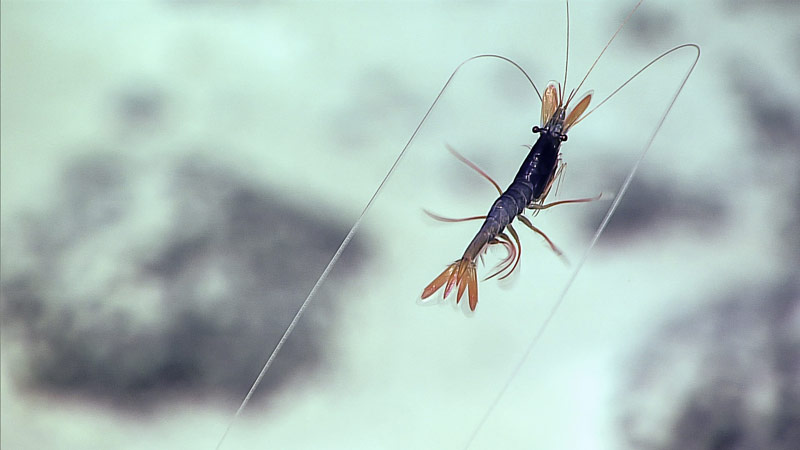
An unusual blue shrimp was imaged for the second time this expedition. Image courtesy of the NOAA Office of Ocean Exploration and Research, Deepwater Wonders of Wake. Download larger version (jpg, 4.7 MB)

An unusual blue shrimp was imaged for the second time this expedition. Image courtesy of the NOAA Office of Ocean Exploration and Research, Deepwater Wonders of Wake. Download larger version (jpg, 4.7 MB)
Dive 14: Slime Star
During the last dive of the expedition, scientists saw this slime star, which uses mucus as a defense mechanism. Video courtesy of the NOAA Office of Ocean Exploration and Research, Deepwater Wonders of Wake. Download larger version (mp4, 54.7 MB)
We conducted our 14th and final dive of the expedition on an unnamed guyot with a curious mound-shaped feature that may or may not be volcanic in origin. If it turns out to be volcanic, then it could have formed as a result of rejuvenated volcanism. The remotely operated vehicle (ROV) began the benthic part of the dive on the flat guyot summit next to the feature. The ROV then move to the feature and up its flank until it reached the top. This dive was one of the shallowest dives on a guyot in the monument since most of the planned track was above the main flat summit. We hoped this dive would also provide data and samples for use in determining the geologic history of this seamount. Unfortunately, this dive was again affected by weather conditions. The weather turned progressively worse throughout the day, and the decision was made to bring the vehicles up to the surface after 3.5 hours on the seafloor. When we first made contact with the bottom, we found a field of cobbles and boulders with sediment between the rocks instead of the expected sandy seafloor. It appeared that at least this part of the summit was covered with manganese (Mn)-encrusted rocks that looked like pillow lavas forming a series of pillow mounds. A Mn-encrusted basalt sample was obtained from the edge of one of these mounds. As we arrived at the edge of the cone, the surface became even more consolidated, showing larger Mn-encrusted surfaces, and again appearing to be formed from pillow (and tube) lavas. A fairly uneven terrain was present on the slopes, with multi-meter high offsets. As the dive progressed, the vehicles ended up on the edge of a slightly more level area (before the remainder of the dome's edge), which showed more sediment between the Mn-encrusted rocks. The dive was cut short well before the final way point was reached, having covered just under half of the planned dive track, leaving the bottom around 1,200 meters. The top of the guyot and the dome feature were home to many more animals than expected, the most abundant of which were primnoid corals. We also observed bamboo and plexarid corals, an unusual blue shrimp, and several sea pens. Aside from the primnoids, fishes were the most numerous animals near and on the dome. Once the ROVs were safely back on deck, we commenced transiting towards Kwajalein.